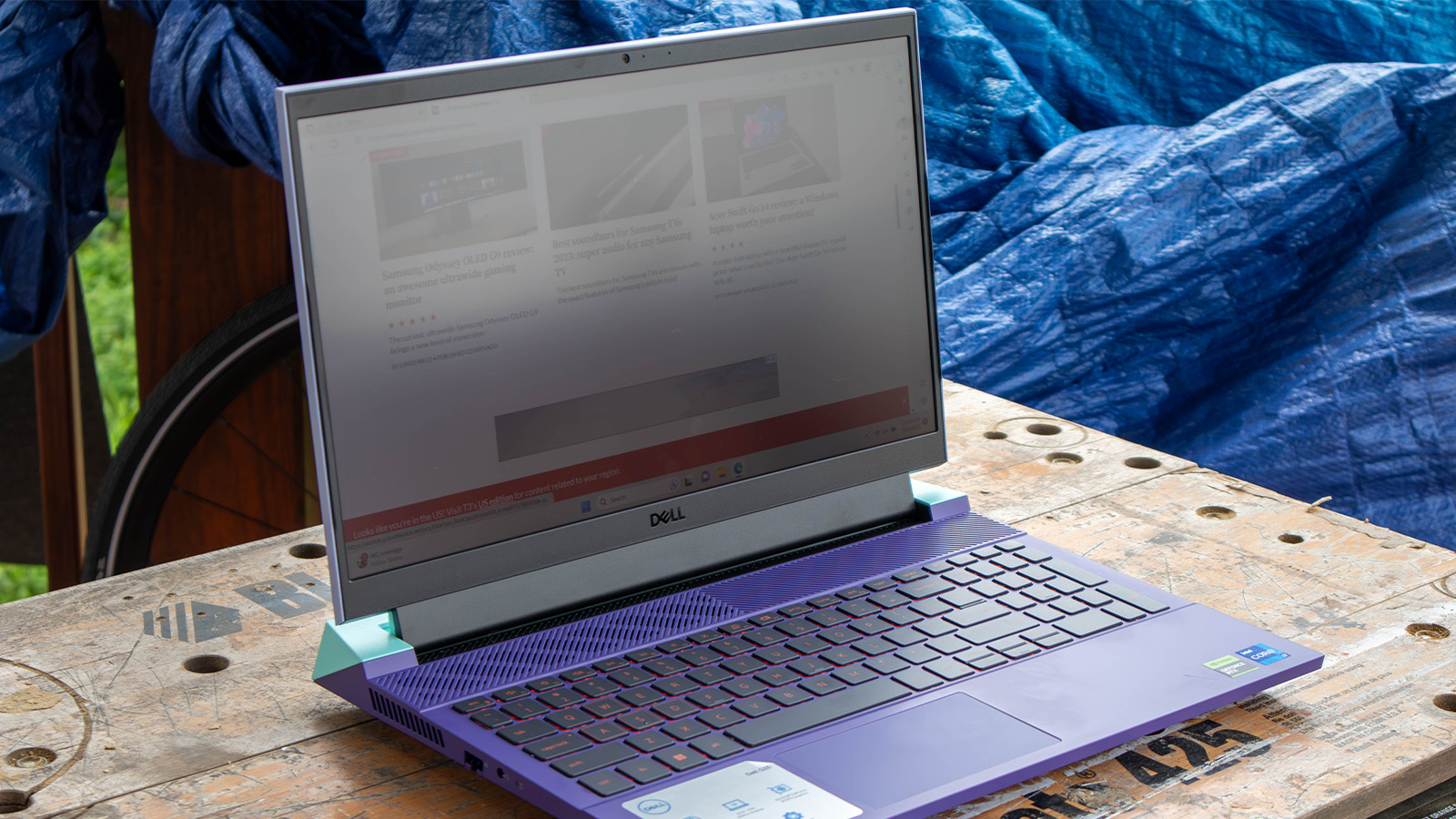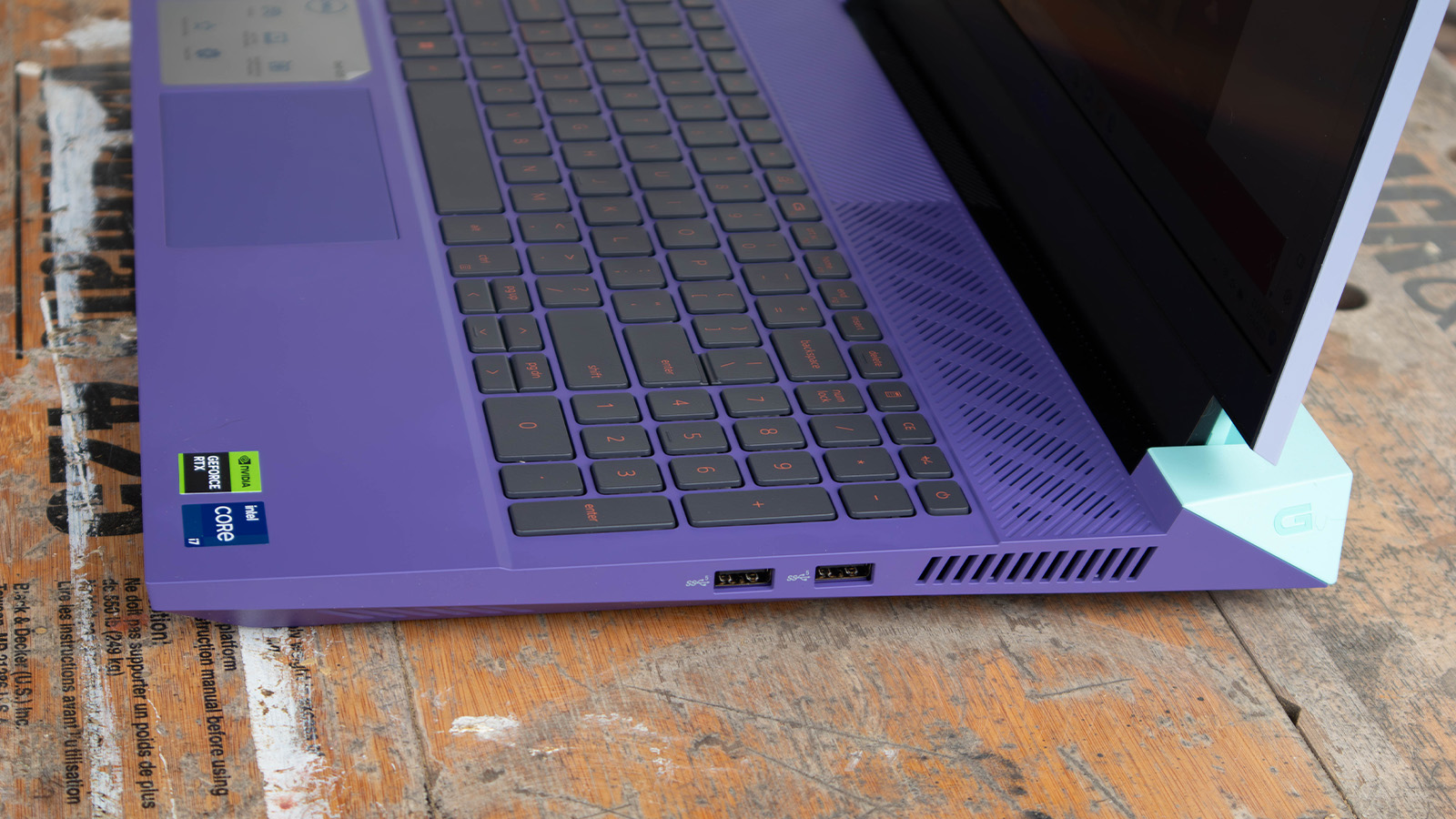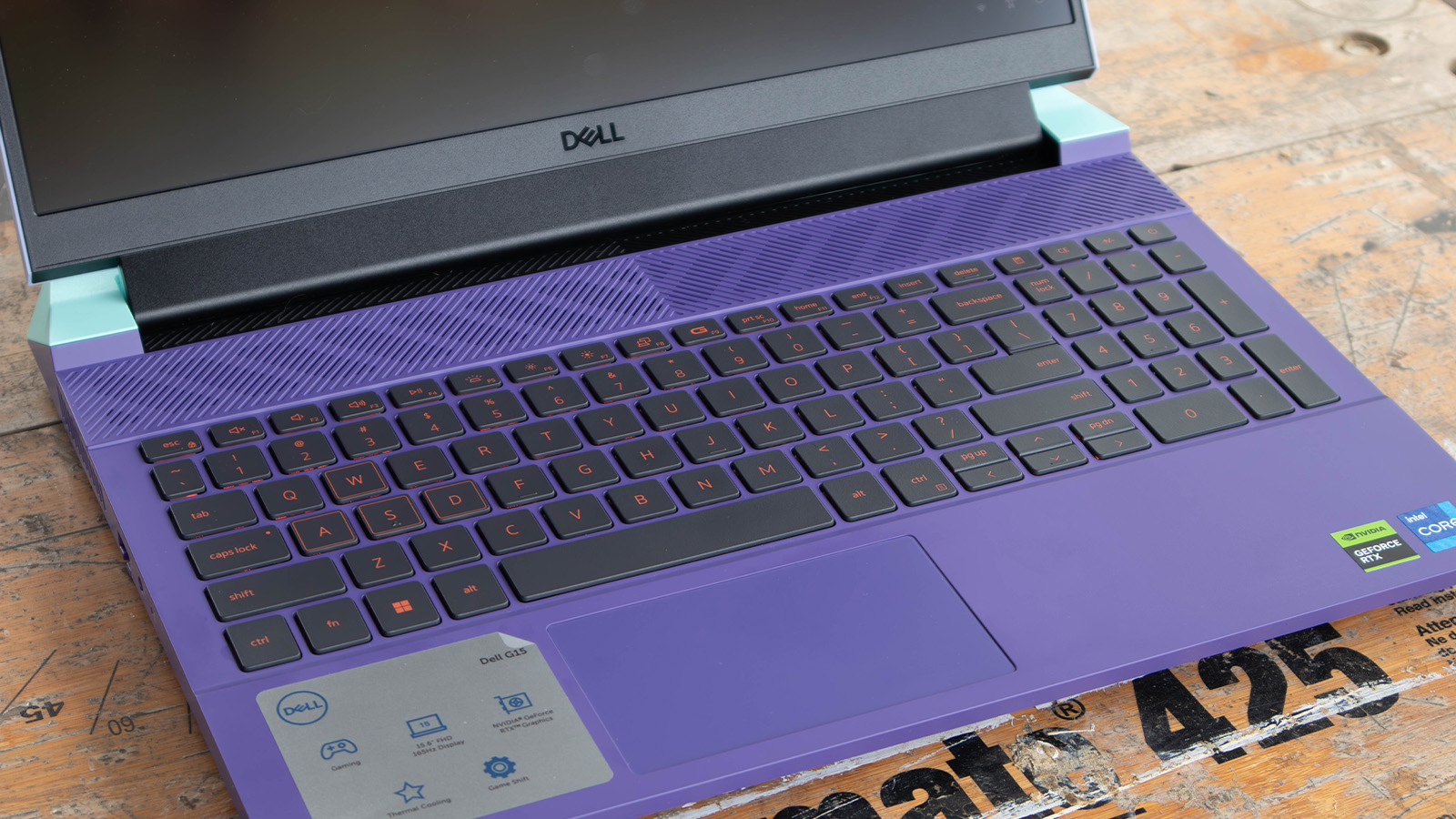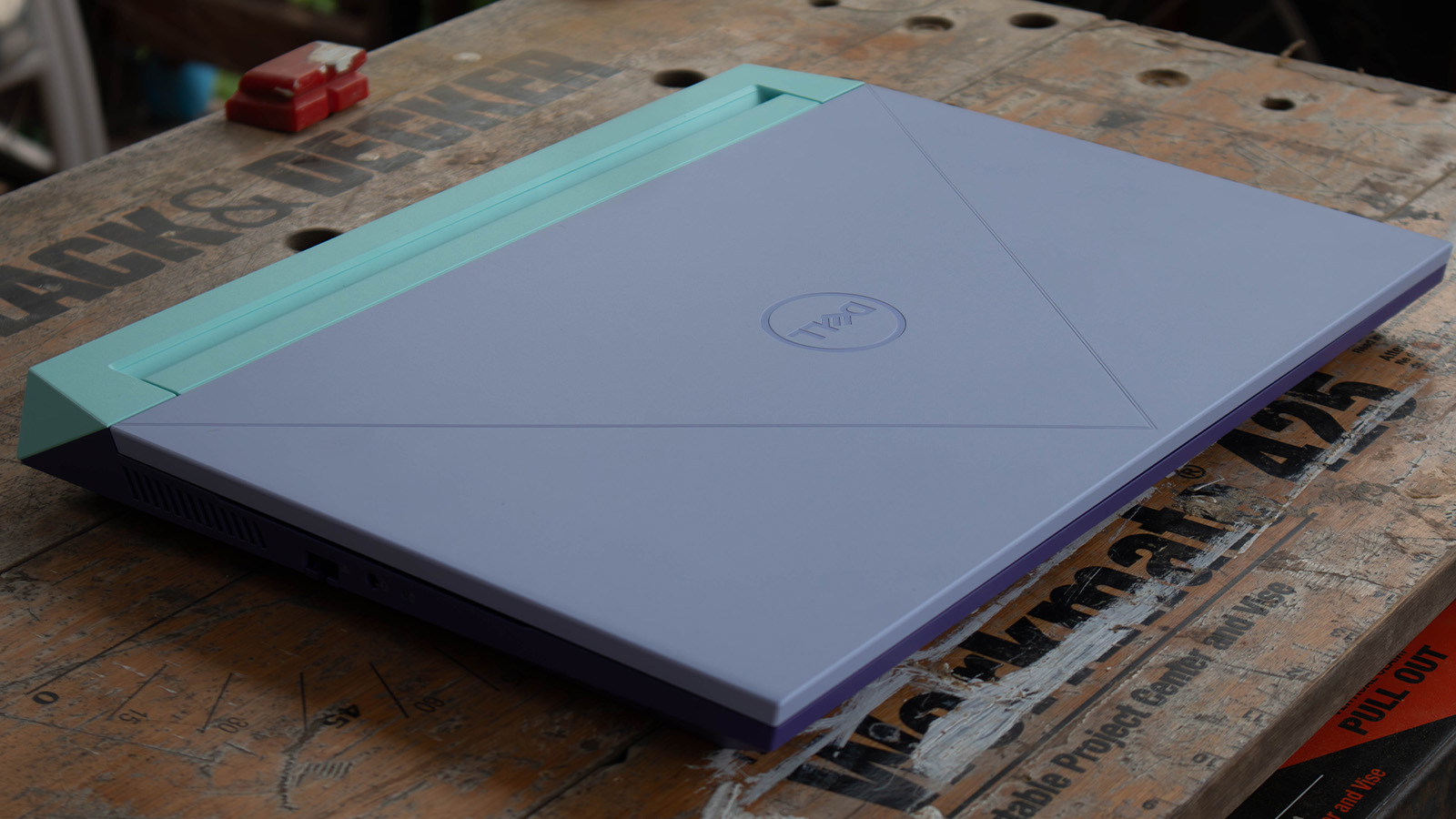
While it may look like something out of the Barbie movie in its purple trim (and that’s no bad thing!), and come in at a pretty petite size, the Dell G15 is in fact a serious laptop at a more affordable price than many of the best gaming laptops.
Gaming machines can run to more than two or even three times the price of this machine, of course, but in this review we’ll weigh up just how impressive the Dell G15 is and its value at the price point on offer. Read on for the verdict.
DELL G15: PRICE & AVAILABILITY
The Dell G15 is available now direct from Dell or other retailers. There are three options for the colour of the case: a fairly standard grey (called Dark Shadow), an off-white Quantum White with a blue back, and a rather attractive Lilac-like colour called Pop Purple with Neo Mint highlights.
The G15 ranges in price from £749/$899 for the low-end model with the Intel Core i5 13450HX processor and Nvidia GeForce GTX 3050 GPU, up to $1659.99 (specs unavailable in the UK for now) for the top-of-the-line unit with the Intel Core i7 13650HX processor, Nvidia GeForce GTX 4060 GPU, 16GB of RAM and the 240Hz Quad HD screen.
The review unit in question here is towards the top end of this range, with the same processor and GPU, but with the slightly lower-res (and therefore cheaper) Full HD screen option, priced all-in at £1299/$1349.
DELL G15 REVIEW: DESIGN
The design of the G15 is certainly striking: the Neo Purple colour of the case is very different from the usual grey or black. I like the colour, but the matte finish does pick up sweaty fingerprints on the wrist rest a bit too easily. It shares some design traits with the more expensive Alienware laptops from Dell, including the extended back and light-up logo, but without the alien head motif and fancy features.
The design is rather angular and blocky, like a child’s toy or an Ikea laptop prop used in a store display rather than the real thing. It is, however, definitely a real laptop, with a large, clear 15.6-inch screen, a chiclet-style keyboard with a numeric keypad, and a large offset touchpad. The keyboard is backlit with LEDs, but these are a single colour and are not individually controllable.
Inside the laptop is a 13th Gen Intel CPU, ranging from the 10-core i5 13450HX (on the cheapest model) to the 14-core i7 13650HX (at the top-end). That is twinned with up to 16GB of DDR5 RAM and an Nvidia GPU, ranging from the RTX 3050 to the RTX 4060. Data is stashed on an NVME SSD ranging in size from 256GB to 1TB. That’s a pretty good range of features and price points that should appeal to most budgets.

There are some obvious compromises with the design to keep the cost down, though. The keyboard has little travel and a soft, mushy feel: it is like typing on a wet towel. It is nice to have a numeric keypad, but the keys are smaller than the main keyboard, and the whole thing feels cramped. The arrow keys are half the size of the letter keys in a layout, so I would keep hitting the page up rather than the left arrow because the two keys are on each other. The touchpad is moderately sized but is offset to the left of the case so it is in the middle of the main keyboard. That makes moving your right hand from the touchpad to the numeric keypad while gaming more of a stretch: you can’t reach by twisting your wrist.
The G15 also gets a bit noisy when running games or other demanding applications, with the two fans that suck air from under the base and vent it from the grille next to the hinge creating a somewhat off-putting whine when running at top speed. Most gaming laptops have this issue, but the large speakers are right next to the vents, so the two sound sources get somewhat mixed. The speakers are quite loud, though, so you can just turn them up and drown out most of the noise. Their sound is rather flat, though, with weak bass and little stereo separation.
DELL G15 REVIEW: DISPLAY
Dell offers a range of display options, from a 120Hz FHD (1920 x 1080 pixels) up to a QHD option (2560 x 1440 pixels). There is also a 360Hz Full HD option for those who want high-frame-rate gaming.
I tested the mid-range 165Hz FHD option and found it was clear and pretty bright, with a maximum brightness of about 350 nits, which means it was usable in sunlight but somewhat pale. The colours look natural, but there's no support for high dynamic range (HDR) video or gaming at this level of brightness.
DELL G15 REVIEW: PERFORMANCE

My review unit came with an Nvidia 4060 GPU and 8GB of video RAM, which is beefy enough to handle modern 3D games without too much of a problem. Running the 3D demon-squashing Doom Eternal, it maxed out the 165Hz screen, producing a blood-splatteringly good 165fps in the Ultra Nightmare graphics mode at the native resolution.
The racing game F1 2022 stretched the G15 a bit more, managing about 68fps at the Ultra High graphics preset. That’s not bad, but it could be better: knocking the detail preset down to Good maxed the screen out at 165Hz for a wonderfully smooth in-the-cockpit driving experience.
So, the G15 is not at the cutting edge of graphics performance, although it is at the upper end of the range. That’s a good place to be, though: it has the power to handle modern games at the full resolution of the screen, although you may have to turn the graphics quality of the game down a couple of notches to enjoy high-frame-rate gaming.
DELL G15 REVIEW: FEATURES
The G15 has a fairly standard set of other features: a 720P webcam is built into the top of the display frame and Wi-Fi 6 is also included (not the newer and faster Wi-Fi 6E version). There is no space inside the case for more than 16GB of RAM, though, and the single NVMe slot supports only a single 1TB SSD. If you want more storage space, attach an external drive to one of the USB ports.
There is a good selection of ports, fortunately, with three USB 3.2 Gen 1 ports (two on the right side) and a single USB-C Gen 2 port on the back that can also be used to connect to a monitor. There is also an HDMI 2.1 port but no DisplayPort outputs or Thunderbolt 4 ports.
Power is supplied by a very large (and heavy) proprietary power adapter that plugs into a large socket on the back. You can’t power this laptop from a USB-C power supply, so you must take this brick of a power adapter with you when you travel. That’s a pain, adding to the travel weight of an already heavy laptop.
DELL G15 REVIEW: BATTERY LIFE

Gaming laptops are not known for having long battery life, so it is no surprise that the G15 has a pretty poor battery life. When running Doom Eternal, I could only enjoy about 45 minutes of Demon-splatting before the 86Whr battery ran out of juice.
I also ran the PC Mark 10 battery life test, which simulated light office work and managed about 2 hours and 35 minutes. So, if you want to watch a movie on a flight, the G15 might just about be able to manage it but don’t expect to manage cinematic gaming experiences in that scenario.
DELL G15 REVIEW: VERDICT
The G15 is a good balance of price versus performance: it has enough gaming and processor performance to manage modern games but without the wallet-busting expense of its cousins like the Alienware M18.
You get excellent gaming performance for the price, plenty of storage space, and a fast processor. What you don’t get is much in the way of expandability: the memory maxes out at 16GB, the SSD storage at 1TB. Oh, and the keyboard really isn't great, plus the design feels a little clumsy.
None of that is likely to be a problem for most gamers, though: the Dell G15 is more than adequate for modern games – easily hitting the 165fps of this Full HD display in many cases – and therefore represents excellent value for money in a market where the competition often costs much, much more.
Also consider
We’ve reviewed a lot of the best gaming laptops over the years. There are a number of good alternatives to the Dell G15, too. If you are looking for the best gaming performance and price is no object, the Razer Blade 15 Advanced is about the same size as the Dell, but with a faster processor, GPU, and screen. Otherwise the Alienware M16 has a similar design to the G15 (both are made by Dell and use some components in common) but with more options for memory, storage and a bigger screen.







